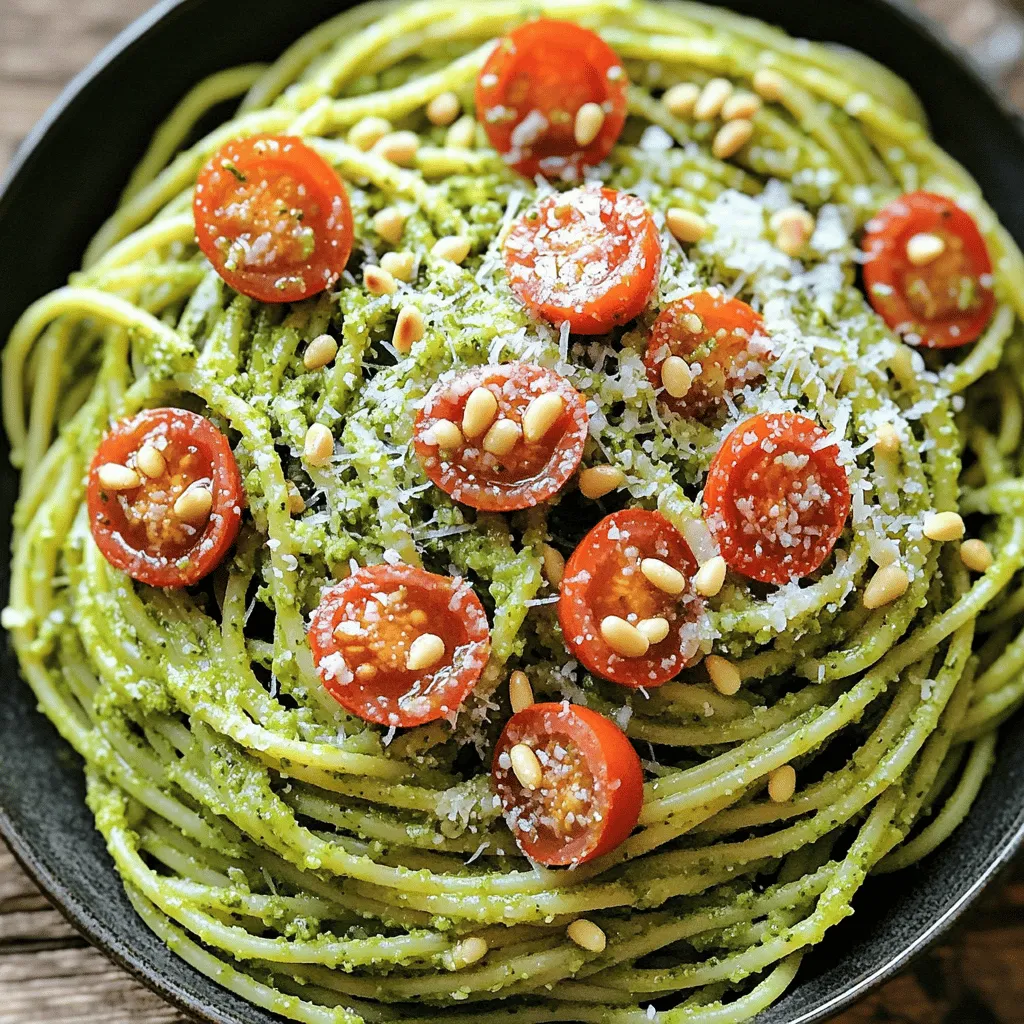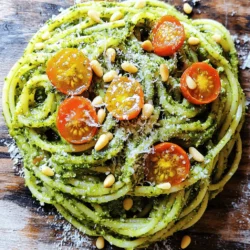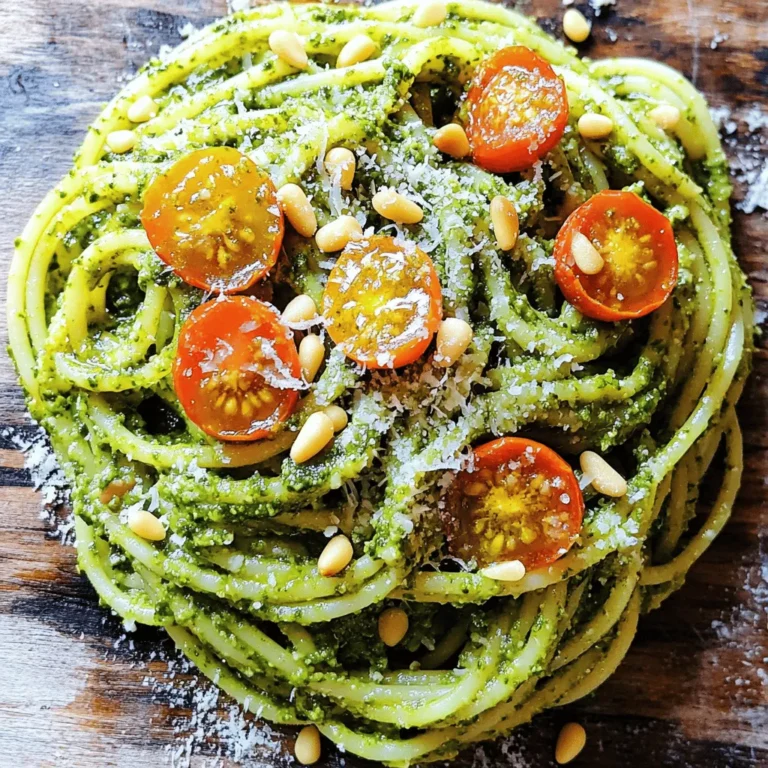Craving a burst of fresh flavor? Classic Pesto Pasta is your answer! This easy recipe combines fresh basil, garlic, and Parmesan in a vibrant sauce. Whether you’re cooking for yourself or impressing guests, you’ll love how simple it is to make. Dive in as I share my favorite tips, step-by-step instructions, and delicious variations to elevate your pasta game. Get ready to bring a taste of Italy to your kitchen!
Ingredients
Essential Ingredients for Classic Pesto Pasta
– Fresh basil leaves
– Extra-virgin olive oil
– Pine nuts (or walnuts as a substitute)
– Garlic
– Parmesan cheese
– Salt and black pepper
– Pasta of choice (spaghetti recommended)
– Optional garnish: cherry tomatoes, lemon juice
To make classic pesto pasta, you need a few key ingredients. Fresh basil leaves are a must. They give the dish its bright, fresh flavor. Extra-virgin olive oil adds richness. It helps blend the sauce smoothly.
Pine nuts bring a nice crunch. If you want a twist, use walnuts instead. Garlic adds a punch of taste. Freshly grated Parmesan cheese gives depth and creaminess. A pinch of salt and black pepper enhances all the flavors.
You can choose your favorite pasta, but I recommend spaghetti. It holds the pesto well. For a burst of color, add halved cherry tomatoes on top. Squeezing fresh lemon juice brightens the dish even more.
These ingredients work together to create a flavorful and fresh meal.
Step-by-Step Instructions
Cooking the Pasta
To start, bring a large pot of salted water to a boil. When the water is bubbling, add the pasta. I recommend using spaghetti, but any pasta works well. Cook according to the package instructions, usually 8-10 minutes. You want your pasta to be al dente, which means it should have a slight bite. A quick tip: taste a strand just before draining to check the texture.
Before draining the pasta, save about 1 cup of the pasta water. This water is rich in starch and will help mix the sauce later. Drain the pasta and set it aside.
Making the Pesto
Now, let’s make the pesto. Grab your food processor and add the fresh basil leaves, pine nuts (or walnuts), minced garlic, and grated Parmesan cheese. Pulse these ingredients together until they are finely chopped. You want a nice, fragrant base for your sauce.
Next, with the food processor running, slowly drizzle in the olive oil. This step is key, as it helps emulsify the pesto and makes it creamy. You might need to stop and scrape down the sides of the bowl a few times to ensure everything mixes evenly.
Once smooth, season your pesto with salt, black pepper, and fresh lemon juice. Pulse a few more times to blend everything. Taste it. Adjust the seasoning if needed. You can add more lemon for brightness or cheese for richness.
Mixing Pasta and Pesto
Now it’s time to mix the pasta and pesto. In a large bowl, add the cooked pasta. Pour the pesto sauce over it. Toss the pasta to coat it well. If the pesto feels too thick, gradually add some reserved pasta water. This will help achieve your desired creamy consistency.
For presentation, plate the pasta into individual bowls. Top with halved cherry tomatoes for a pop of color. If you want to impress, sprinkle some extra grated Parmesan on top and drizzle with a bit more olive oil.
This is a simple yet satisfying dish. Your friends and family will love it!
Tips & Tricks
Perfecting Your Pesto
Using fresh ingredients is key for great flavor. Fresh basil makes pesto bright and vibrant. Dried herbs lack that fresh taste. You can tweak the flavor by adding more garlic or lemon juice. If you want a nutty twist, try adding more pine nuts or walnuts. To store pesto, place it in a jar and cover it with oil. This helps keep it fresh. It can last in the fridge for about a week.
Pasta Cooking Techniques
To achieve the best pasta, cook it until al dente. This means it will still have a slight bite. Follow the package instructions, and taste a strand before draining. Save some pasta water before you drain it. This water is starchy and helps the sauce stick to the pasta. Avoid overcooked pasta by setting a timer. If the pasta cooks too long, it can turn mushy.
Garnishing and Serving Suggestions
Get creative when serving classic pesto pasta. You can add cherry tomatoes for a pop of color. Sprinkle extra Parmesan cheese on top for richness. Fresh herbs like parsley or arugula also add a nice touch. Avoid common mistakes by not drowning the pasta in pesto. Instead, coat it lightly for a balanced taste. For more fun, pair it with grilled chicken or shrimp for added protein.

Variations
Alternative Ingredients
You can easily switch nuts in your pesto. Pine nuts are classic, but walnuts work too. They give a different taste, which many enjoy. If you want to try more options, sunflower seeds or almonds can also be great substitutes. Each nut brings its own flavor and texture.
Cheese is another area to explore. Parmesan is a must in classic pesto, but you can use Pecorino Romano for a sharper taste. For a creamier bite, try adding ricotta. Just remember to balance the flavors so it does not overpower the dish.
Adding more veggies to your pasta can boost both taste and nutrition. Consider adding spinach or kale to your pesto for extra greens. You can even toss in roasted red peppers for a smoky flavor. This not only makes the dish colorful but also adds more layers of taste.
Dietary Adjustments
Making a vegan version of pesto is simple. Just swap out the cheese for nutritional yeast. This gives a cheesy flavor without dairy. You can also use cashews or avocado for creaminess.
If you need gluten-free options, choose gluten-free pasta. Quinoa or rice pasta works well and has great texture. You won’t miss out on flavor with these options.
For those on low-carb diets, spaghetti squash or zucchini noodles are excellent. They serve as a great base for pesto and keep the dish light. Simply spiralize your veggies, and you have a healthy pasta alternative.
Creative Pasta Dishes
Want to make your dish heartier? Incorporate proteins like chicken or shrimp. Grilled or sautéed, they add great flavor. Toss them in right before serving for the best results.
For a refreshing twist, try pesto pasta salads. Mix your pasta with pesto, cherry tomatoes, and fresh mozzarella. Chill it for a delightful cold dish, perfect for summer days.
Don’t hesitate to mix cuisines. Try adding Asian flavors by mixing in sesame oil and soy sauce. This fusion creates a unique pesto dish that surprises everyone. The possibilities are endless!
Storage Info
Storing Pesto
To keep your homemade pesto fresh, store it in an airtight container. Press plastic wrap directly onto the surface to limit air exposure. This helps prevent browning. You can refrigerate pesto for up to a week. For longer storage, consider freezing it. Pour pesto into ice cube trays and freeze. Once solid, transfer the cubes to a zip-top bag. These cubes are perfect for quick meals. Always check your pesto before use. If it smells sour or has changed color, discard it.
Storing Cooked Pasta
After cooking pasta, let it cool to room temperature. Place it in an airtight container to avoid drying out. Cooked pasta can be stored in the fridge for about three to five days. When reheating, add a splash of water or olive oil. This helps restore its texture. You can also microwave it covered to keep moisture in. Just be careful not to overheat it.
Combining Storage Tips
For best results, store pesto and pasta separately. This keeps the pasta from getting soggy. You can mix them just before serving. When meal prepping, package them together but keep the sauce on the side. This way, you can control how much sauce you want. It also helps the pasta stay fresh longer. If you have leftover pesto pasta, eat it within two days for the best flavor.
FAQs
How do I make classic pesto pasta from scratch?
To make classic pesto pasta, first cook the pasta. Boil water in a pot, add the pasta, and cook until al dente. While the pasta cooks, prepare the pesto. Use a food processor to blend fresh basil, nuts, garlic, and cheese. Slowly add olive oil to create a creamy sauce. Once the pasta is ready, mix it with the pesto. Add some reserved pasta water to get the right texture. Serve it warm, and enjoy!
Can I use other nuts in pesto?
Yes, you can use other nuts in pesto. Pine nuts are traditional, but walnuts work well too. They add a different flavor and texture. You might also try almonds or cashews for a unique twist. Each nut brings its own taste and makes the pesto special.
What is the best pasta to pair with pesto?
Spaghetti is a classic choice for pesto. It holds the sauce well and has a nice texture. You can also use linguine or fettuccine for a change. If you prefer, try whole wheat or gluten-free pasta. Each type brings a different taste, but spaghetti is often the favorite.
How can I enhance the flavor of my pesto?
To enhance your pesto, adjust the garlic and cheese amounts. More garlic gives a stronger taste. Extra cheese adds creaminess and richness. You can also add a splash of lemon juice for brightness. If you want a bit of heat, add red pepper flakes. Taste your pesto as you go and make it your own.
How long does homemade pesto last?
Homemade pesto lasts about a week in the fridge. Store it in an airtight container to keep it fresh. You can also freeze pesto for up to three months. Just make sure to leave some space in the container, as it may expand. Check for any color change or off smells before using it.
Classic pesto pasta is easy to make with fresh ingredients. You combine simple elements like basil, garlic, and nuts for rich flavor. Cooking pasta to the right texture is crucial for the best result. Remember to save some pasta water to adjust the consistency of the sauce. You can also make variations that suit your diet or preferences. Store your pesto and pasta properly to keep them fresh. Enjoy experimenting with new twists on this dish while using the tips shared. Simple steps lead to great meals. Happy cooking!


